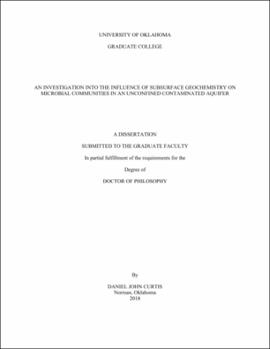| dc.description.abstract | Microorganisms account for ~ 90 gigatons of carbon in terms of global biomass and are important drivers of elemental cycling especially in oligotrophic subsurface environments. Subsurface ecosystems remain poorly characterized in terms of understanding the roles microorganisms play in biogeochemical processes. While we are handicapped by our ability to cultivate the vast majority of microbial diversity, genomic approaches are rapidly expanding our understanding of the complex microbial communities that are found in these ecosystems. Anthropogenic sources are a major contributor to imbalances in natural systems primarily through the release of environmental contaminants and changes in environmental geochemistry arising from increased contaminant levels has lasting impacts on microbial function. Contamination at the Oak Ridge Integrated Field Research Center (OR-IFRC) is centered around the waste byproducts of uranium refining operations and the site is defined by a subsurface plume with gradients in pH, uranium (U) and nitrate (NO3).
In Chapter 2, I investigate the effect of changes in groundwater pH on the subsurface microbial community during a field treatment experiment designed to chemically sequester U(VI) in a highly contaminated zone (Area-3) at the OR-IFRC. A comprehensive microbial functional gene array (GeoChip 4.2) was used to infer changes in microbial community composition and functional potential during base amendment. Changes in subsurface geochemistry influenced considerable shifts in the overall microbial community structure. Relative to pre-manipulation conditions, functional genes involved in carbon (C), nitrogen (N), sulfur (S), and phosphorus (P) cycling processes increased in relative abundance as pH shifted between 3.5 – 4.5 units before sharply decreasing as the groundwater reached the targeted pH of ~ 5.0 units. Microbial populations promoting metal reducing conditions and known U(VI) reducing species were studied using nitrate reductase (nirK/S), dissimilatory sulfate reductase (dsrAB) and cytochrome c/hydrogenase probes on the array. However, weak responses in relation to PM conditions were observed during base amendment. The small increases in gene abundance between pH 3.5 – 4.0 and the subsequent sharp decrease in the abundance of genes across functional categories near pH 5.0 point to the overarching inhibition of a low pH adapted community due to changes in subsurface geochemistry. While the concentration of U(VI) was dramatically reduced and thereby rendered the abiotic sequestration successful, a net inhibitory effect of the complex changes in subsurface geochemistry on the microbial community was identified.
Nitrate is primary groundwater contaminant at the OR-IFRC with large gradients observed in the subsurface. In Chapter 3, I examine the composition of subsurface microbial communities at the OR-IFRC along a nitrate gradient. 20 wells were selected from a groundwater survey conducted at the reservation in 2012-2013 and grouped in to three categories spanning low (< 1mgL-1 NO3), moderate (10-100 mgL-1 NO3) and high (> 100 mgL-1 NO3). Groundwater communities were studied using 16S rRNA amplicon sequencing and with the GeoChip 5.0 functional gene microarray. The taxonomic composition of groundwater communities exhibited stronger differences compared to the functional composition between the treatment groups. Overall functional potential for gene spanning C, N, S cycling and electron transfer processes were enriched under NO3 levels spanning 10-100 mgL-1. Microbial populations important to bioremediation of U(VI) were structured along the gradient based on the analysis of nirK/S, dsrAB and cytcochrome c/hydrogenase sequences with increased functional potential evident at moderate NO3. Apart from NO3, pH, carbon, anions and redox conditions influenced the taxonomic and functional composition across the treatment groups.
The acidic wastes that characterize the OR-IFRC have generated extremely acidic conditions in the subsurface near the former S-3 waste disposal ponds. However, the underlying geology also induces zones of alkalinity in the unconfined aquifer. Chapter 3 explores the microbial communities identified in 24 wells spanning acidic (pH < 6.0), circumneutral (pH 7.0 – 8.0) and alkaline (pH > 9.0) conditions at the site and the influence of groundwater geochemistry in these wells on microbial function. Groundwater communities were examined using 16S rRNA gene amplicon sequencing and the GeoChip 5.0 functional gene microarray. Differences in taxonomic community composition were not identified between ORA and ORCN wells while differences in functional composition were evident between all treatments. However, taxonomic differences were stronger compared to hose based on functional gene content. The relative gene abundance of genes influencing C, N and S cycling and the transfer of electrons was enriched in ORALK wells compared to both ORA and ORCN wells. Populations important to U(VI) remediation efforts at the site were structured along the pH gradient and their functional potential was greatly reduced in ORA wells, though some sulfate reducing species were enriched under low pH conditions. Al, Ca, SO4 and DIC (Dissolved Inorganic Carbon) were other components of subsurface geochemistry that influenced both taxonomic and functional gene composition across the treatment groups.
My research highlights how groundwater geochemistry can shape subsurface microbial communities at the OR-IFRC. The response to pH amendment and concomitant changes in geochemistry shed light on the dynamics and reduced functional potential seen in subsurface communities resulting from the first field implementation of this approach to abiotically sequester U(VI). Furthermore, nitrate and pH govern sitewide subsurface community composition and play an important role structuring microbial functional potential at the OR-IFRC. | en_US |
